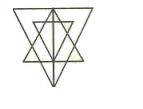DIRECTIONS : Count the number of cubes in each of the following figures.
| 6. |
 |
|
A. 8 |
B. 10 |
|
C. 11 | D. 12 | | | | |
|
| | | | | | | | | | | | | | | | | | | | | | | | | | | | | | | | | | | | | | | | | | | | | | | | | | | | | | | | | | | | | | | | | | | | | | | | | | | | | | | | | | | | | | | | | | | |
| Ans : A. The simplest triangles are ABG, BCG, CGE, CDE, AGE and AEF i.e. 6 in number. |
| 7. |
 |
|---|
|
A. 21 |
B. 23 |
|
C. 25 |
D. 27 | |
| Ans : B. The figure may be labelled as shown. The simplest triangles are GLK, DLJ, DJM, HMN, QRE, IRA, IPA, and FPO i.e. 8 in number. Thus there are 8 + 10 + 5 + 2 + 1 + 1 = 27 triangles in the figure. |
| 8. |
 |
|---|
|
A. 4 |
B. 5 |
|
C. 6 |
D. 7 |
| Ans : B. We may label the figure as shown. The simplest triangles are ADE, BDF, DEF and EFC. i.e., 4 in figure. There is only one triangle ABC composed of four components. Thus, there are 4 + 1 = 5 triangles in the given figure. |
| 9. |
 |
|---|
|
A. 15 |
B. 16 |
|
C. 16 |
D. 18 |
| Ans : C. The figure may be labelled as shown. The simple triangles are ABF, BFG, BCG, CGH, GHD, GED, EFG, and AFG i.e. 8 in number. Thus there are 8 + 5 + 4 = 17 triangles in the given figure. |
| 10. |
 |
|---|
|
A. 16 | |
B. 13 |
|
C. 9 | |
D. 7 | | | | | | | |
Ans : A. The figure may be labelled
as shown. The simple triangles are AGE, EGC, GFC, BGF, DGB and ADG i.e.,
6 in number. Thus there are 6 + 3 + 6 + 1 = 16 triangles in the given
figure. |





No comments:
Post a Comment